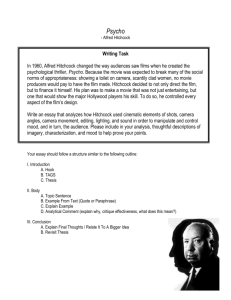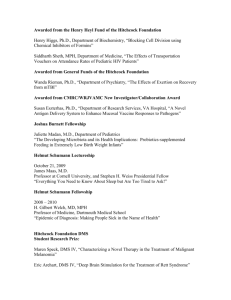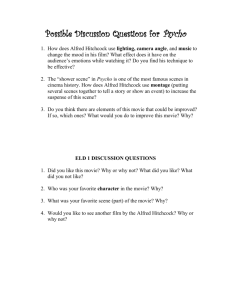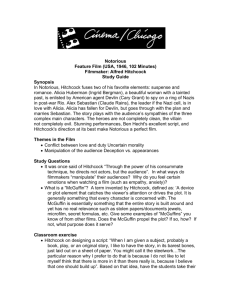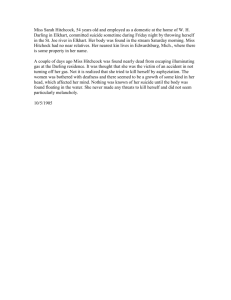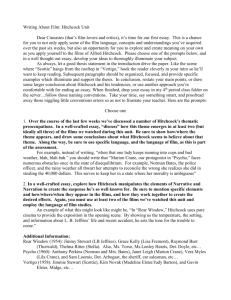Hitchcock SYL (Modified)
advertisement
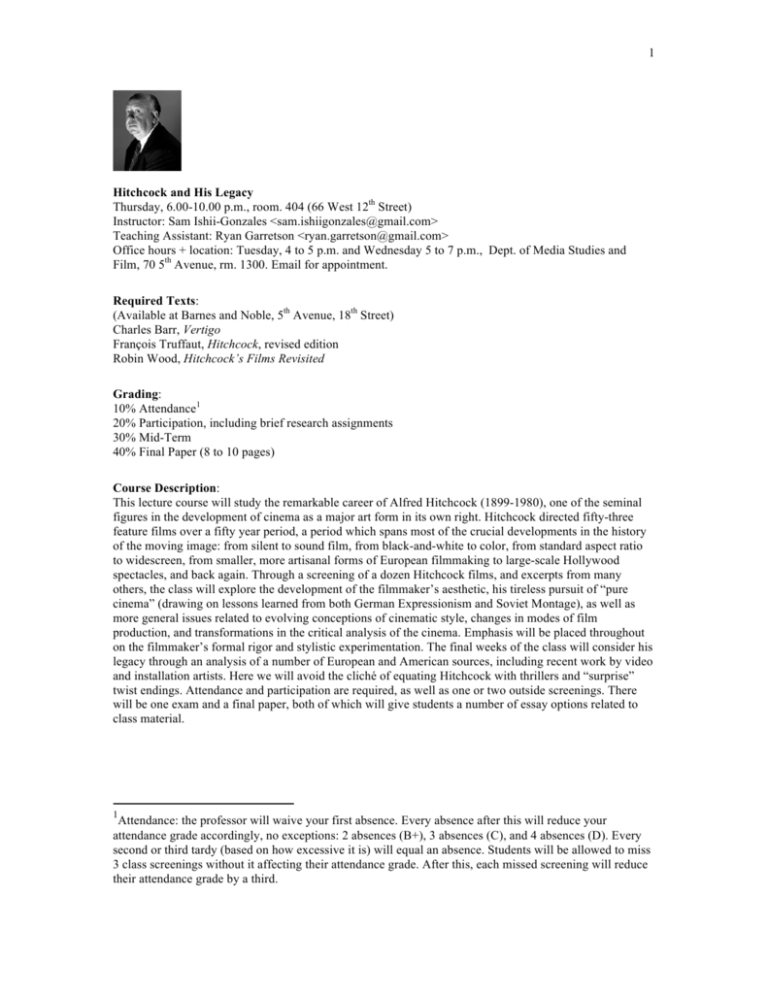
1 Hitchcock and His Legacy Thursday, 6.00-10.00 p.m., room. 404 (66 West 12th Street) Instructor: Sam Ishii-Gonzales <sam.ishiigonzales@gmail.com> Teaching Assistant: Ryan Garretson <ryan.garretson@gmail.com> Office hours + location: Tuesday, 4 to 5 p.m. and Wednesday 5 to 7 p.m., Dept. of Media Studies and Film, 70 5th Avenue, rm. 1300. Email for appointment. Required Texts: (Available at Barnes and Noble, 5th Avenue, 18th Street) Charles Barr, Vertigo François Truffaut, Hitchcock, revised edition Robin Wood, Hitchcock’s Films Revisited Grading: 10% Attendance1 20% Participation, including brief research assignments 30% Mid-Term 40% Final Paper (8 to 10 pages) Course Description: This lecture course will study the remarkable career of Alfred Hitchcock (1899-1980), one of the seminal figures in the development of cinema as a major art form in its own right. Hitchcock directed fifty-three feature films over a fifty year period, a period which spans most of the crucial developments in the history of the moving image: from silent to sound film, from black-and-white to color, from standard aspect ratio to widescreen, from smaller, more artisanal forms of European filmmaking to large-scale Hollywood spectacles, and back again. Through a screening of a dozen Hitchcock films, and excerpts from many others, the class will explore the development of the filmmaker’s aesthetic, his tireless pursuit of “pure cinema” (drawing on lessons learned from both German Expressionism and Soviet Montage), as well as more general issues related to evolving conceptions of cinematic style, changes in modes of film production, and transformations in the critical analysis of the cinema. Emphasis will be placed throughout on the filmmaker’s formal rigor and stylistic experimentation. The final weeks of the class will consider his legacy through an analysis of a number of European and American sources, including recent work by video and installation artists. Here we will avoid the cliché of equating Hitchcock with thrillers and “surprise” twist endings. Attendance and participation are required, as well as one or two outside screenings. There will be one exam and a final paper, both of which will give students a number of essay options related to class material. 1 Attendance: the professor will waive your first absence. Every absence after this will reduce your attendance grade accordingly, no exceptions: 2 absences (B+), 3 absences (C), and 4 absences (D). Every second or third tardy (based on how excessive it is) will equal an absence. Students will be allowed to miss 3 class screenings without it affecting their attendance grade. After this, each missed screening will reduce their attendance grade by a third. 2 Weekly Schedule 27 January Snow Day – Class Cancelled February 3 Session I: Introduction to Course • Apprenticeship in Cinema • Cinema, 1895 to 1920 • German Influence (Expressionism) Film: The Lodger (Alfred Hitchcock, 1926), plus Snowball Fight (Lumière Brothers, c1897), Great Train Robbery (Edwin S. Porter, 1903) Clips from Lonesdale Operator (D.W. Griffith, 1911), Cabinet of Dr. Caligari (Robert Weine, 1919) and The Last Laugh (F.W. Murnau, 1924) Reading: François Truffaut, Hitchcock, pp. 25-87. Robin Wood, “Introduction (1965),” in Hitchcock’s Films Revisited, pp. 55-85. February 10 Session II: British Period (1925-1939) • Hitchcock, Master of Suspense • Soviet Influence (Montage) • Acting for the Cinema Film: The 39 Steps (Hitchcock, 1935) Clips from Potemkin (Sergei Eisenstein, 1925), The Ring (Hitchcock, 1927), Blackmail (Hitchcock, 1929), Sabotage (Hitchcock, 1936), Foreign Correspondent (Hitchcock, 1940), and A Talk with Hitchcock (Fletcher Markle, 1964) Reading: François Truffaut, Hitchcock, pp. 89-125. Alfred Hitchcock, “Direction,” on Blackboard (BB). 2 Pascal Bonitzer, “Hitchcockian Suspense,” on BB. V.I. Pudovkin, excerpt from Film Technique and Film Acting on BB. February 17 Session III: Hitchcock in Hollywood • Hollywood Studio System • Against Coverage Film: Shadow of a Doubt (Hitchcock, 1943) Clips from Rebecca (Hitchcock, 1940), The Big Sleep (Howard Hawks, 1946), and Visions of Light (Arnold Glassman and Todd McCarthy, 1992) Reading: François Truffaut, Hitchcock, pp. 127-51. Robin Wood, “Norms and Variations: The 39 Steps and Young and Innocent,” in Hitchcock’s Films Revisited, pp. 275-87. David Bordwell and Kristen Thompson, “The Hollywood Studio System, 1930-1945,” on BB. Background reading: David Bordwell and Kristen Thompson, “Continuity Editing” (excerpt), on BB. 2 All readings other than the three course textbooks will be posted to Blackboard unless otherwise noted. 3 February 24 Session IV: Hitchcock Under Contract • Hitchcock, Surrealism, and Psychoanalysis Film: Notorious (Hitchcock, 1946) Clips from Un Chien Andalou (Luis Buñuel and Salvador Dali, 1928), Spellbound (Hitchcock, 1945), and Memory of the Camps (Hitchcock et al., c1945) Reading: François Truffaut, Hitchcock, pp. 151-67. Robin Wood, “Ideology, Genre, Auteur,” in Hitchcock’s Films Revisited, pp. 288-302. Lindsay Anderson, “Alfred Hitchcock,” on BB. Mladen Dolar, “Hitchcock’s Objects,” on BB (read first section on Shadow of a Doubt). March 3 Session V: Hitchcock, Independent Filmmaker • La Caméra-Stylo or Writing with the Camera Film: Rope (Hitchcock, 1948) Clips from Rules of the Game (Jean Renoir, 1939), Citizen Kane (Orson Welles, 1941), and Lifeboat (1944) Reading: François Truffaut, Hitchcock, pp. 167-77. Robin Wood, “Star and Auteur: Hitchcock’s Films with Bergman,” in Hitchcock’s Films Revisited, pp. 303-35. Alexandre Astruc, “The Birth of a New Avant-Garde: La caméra-stylo,” on BB. David Bordwell and Kristen Thompson, “American Cinema in the Postwar Era, 1945-1960,” on BB. Pascal Bonitzer, “Notorious,” on BB. March 10 Session VI: Hitchcock’s America • Doppelgänger – Figure of the Double • The Uncanny Film: Strangers on a Train (Hitchcock, 1951) Clip from Under Capricorn (Hitchcock, 1949) Reading: François Truffaut, Hitchcock, pp. 179-91. Robin Wood, “The Murderous Gays: Hitchcock’s Homophobia,” in Hitchcock’s Films Revisited, pp. 33657. Sigmund Freud, “The Uncanny,” on BB. Jean-Pierre Coursodon, “Desire Roped In: Notes on the Fetishism of the Long Take in Rope,” on BB. V.F. Perkins, “Rope,” on BB. March 17 No Class – Spring Break March 24 Session VII: Hitchcock, Auteur • Transfer of Guilt Film: Rear Window (Hitchcock, 1954) Clips from I Confess (Hitchcock, 1953), Dial ‘M’ for Murder (Hitchcock, 1954) and Man Who Knew Too Much (Hitchcock, 1956) Reading: François Truffaut, Hitchcock, pp. 193-207. Robin Wood, “Strangers on a Train,” in Hitchcock’s Films Revisited, pp. 86-99. Mladen Dolar, “Hitchcock’s Objects,” on BB (second half on Strangers on a Train). 4 Patricia Highsmith, excerpts from her novel Strangers on a Train on BB. Eric Rohmer and Claude Chabrol, excerpt from Hitchcock: The First Forty-Four Films, on BB. Background Reading: John Caughie, introduction to Theories of Authorship, on BB. March 31 Session VIII: Perfection of the System • Subjectivity and Point of View + Mid-Term Exam (distributed at end of session; part one due on April 7, part two due on April 14) Film: Vertigo (Hitchcock, 1958) Clips from Lady in the Lake (Robert Montgomery, 1947) and The Wrong Man (Hitchcock, 1957) Reading: François Truffaut, Hitchcock, pp. 209-33. Robin Wood, “Rear Window,” in Hitchcock’s Films Revisited, pp. 100-7. Miran Bozovic, “The Man Behind His Own Retina,” on BB. Edward Branigan, “The Point-of-View Shot,” on BB. Jean-Luc Godard, review of The Wrong Man, on BB. Cornell Woolrich, “Rear Window,” on BB. Background Reading: David Bordwell and Kristen Thompson, “Narrative as a Formal System” (excerpt), on BB. April 7 Session IV: “They Were Aroused by Pure Cinema” • Hitchcock and Feminism Film: Psycho (Hitchcock, 1960) + Lamb to the Slaughter (Hitchcock, 1958) Clip from Postman Always Rings Twice (Tay Garnett, 1946) Readings: François Truffaut, Hitchcock, pp. 235-57. Robin Wood, “Vertigo,” in Hitchcock’s Films Revisited, pp. 108-30. Charles Barr, Vertigo. Tania Modleski, “Femininity By Design,” on BB. Laura Mulvey, “Visual and Narrative Pleasure,” on BB. April 14 Session X: Abyss and Beyond • Psycho x 3 Film: The Birds (Hitchcock, 1963) Clips from Psycho (Gus Van Sant, 1998) Readings: François Truffaut, Hitchcock, pp. 259-83. Robin Wood, “Psycho,” in Hitchcock’s Films Revisited, pp. 142-51. Robert Bloch, chapters 1-3 of Psycho, on BB. Jean Douchet, “Hitch and His Audience,” on BB. Laura Mulvey, “Alfred Hitchcock’s Psycho (1960),” on BB. April 21 Session XI: Late Hitchcock • The Film That Never Was: Kaleidoscope Film: Frenzy (Hitchcock, 1972) 5 Clip from Peeping Tom (Michael Powell, 1960), Torn Curtain (Hitchcock, 1966) and Topaz (Hitchcock, 1969), and Henri-George Clouzot’s Inferno (Serge Bromberg, 2009) Reading: François Truffaut, Hitchcock, pp. 285-99, 301-320. Robin Wood, “The Birds,” pp. 152-72. Elisabeth Weis, “The Evolution of Hitchcock’s Aural Style and Sound in The Birds,” on BB. April 28 Session XII: Sixties Art Cinema Film: Blow-Up (Michelangelo Antonioni, 1966) Clip from Repulsion (Roman Polanski, 1965), Bride Wore Black (François Truffaut, 1968), and La femme infidel (Claude Chabrol, 1968) Readings: François Truffaut, Hitchcock, pp. 323-49. Robin Wood, “Retrospective (1977),” in Hitchcock’s Films Revisited, pp. 206-27. András Bálint Kovács, “Narration in Modern Cinema,” on BB. May 5 Session XIII: New Hollywood • Chris Marker on Vertigo (or La Jetée) Film: The Conversation (Francis Ford Coppala, 1974) + La Jetée (Chris Marker, 1962) Clips from Bird with the Crystal Plumage (Dario Argento, 1970), Sisters (Brian De Palma, 1973), Dressed to Kill (De Palma, 1980), Blow-Out (De Palma, 1981), and Sans Soleil (Marker, 1983) Readings: Chris Marker, “Vertigo (A Free Replay),” on BB. Frank P. Tomasulo, “’You’re Tellin Me You Didn’t See’: Hitchcock’s Rear Window and Antonioni’s Blow-Up,” on BB. May 12 Session XIV: After Hitchcock • Psycho 24/7: Douglas Gordon and New Media Film: Caché (Michael Haneke, 2005) + 4 Vertigo (Les LeVeque, 2000) Clip from Phoenix Tapes (Christoph Girardet and Matthias Müller, 1999) and The Pervert’s Guide to Cinema (Sophie Fiennes, 2006) Reading: Slavoj Zizek, “’In His Bold Gaze My Ruin is Writ Large,’” on BB. May 19 Session XV: End of the Line + Final due Film: North by Northwest (Hitchcock, 1959) or Family Plot (Hitchcock, 1976) or Mulholland Drive (David Lynch, 2001) Readings: Kerry Brougher, “Hitch-Hiking in Dreamscapes.” Thomas Levin, “Five Tapes, Four Halls, Two Dreams: Vicissitudes of Surveillant Narration in Michael Haneke’s Caché,” on BB.
